We are of course made up of atoms. Every cell in the body has an atom, about 50 trillion to be exact. And each cell emit 1.4 volts of energy not much, but when you multiply by the number of cells in your body (50 trillion) you get a total voltage of 700 trillion volts of electricity in your body.
How cool that science is now confirming that we are made of energy! There are even types of technology that can show this energy in the body like kirlian photography.
Know we have scientific proof that we are made of energy. That we are FULL of POWER. That we are POWERFULL! Just because we know this doesn't mean we always feel it. In tomorrow's yoga classes we will be working with the second universal principle of alignment, muscle energy to help us feel powerful on our body.
-Class plans-
UPA focus: muscle energy
Theme: we are full of power. Powerful
Antidote: science
Heart quality: pow·er·ful. adjective: having great power or strength.
Synonyms: able, capable, commanding,dynamic, effective, energetic, forceful, mighty, potent, strengthy, sturdy, vigorous, weighty
Antonyms: impotent, incapable, ineffective, unable, weak
Anusara 9-10:30
-warm up-
Table Shalabasana
Table- Shalabasana - airplane - mod. Side plank
Urdhva hastasana- half moon side stretch
Utt:
lunge
W2
-basic-
Dolphin
Partner phinca midline
Sirsasana/ pincha legs together
Sphinx
Forearm plank with cobra legs lifted belly
Cobra
-harder-
Parsvak- half moon- tree
Hrl - knee up 3x Eagle - w3 - w1
W1 clasp hands
Sphinx quad - kick foot back
Trikonasana
-apex-
Side plank tree legs or option full vashistasana
Side plank tree legs to wildthing
-cool down-
Janusirsasana
Ardha matsyandrasana prep
Baddha konasana
FUNdamentals:
-warm up-
1:2 sun 3x
Lunge 3x
AMS
-basic-
Sphinx - lifted plank version
Cobra
W2
Mod. Parsvak
Tree
-harder-
Eagle
Sphinx quad stretch
Pigeon
-apex-
Trikonasana
-cool down-
Ardha hanuman
Frog
Supta pada a b c













